Destiny, the fantastical new online-only sci-fi shooter, is a bit of a mixed bag. Dreamt up by the original Halo developer Bungie, along with publisher Activision, it's one of the most disappointing games we've played in quite some time, yet also one of the most enjoyable. It's a game that we can't stop sinking hour after enjoyable hour into, blasting away aliens and greedily snatching up that precious loot they drop.
It's hard to say exactly what the ever-evolving future of Destiny will be; whether in a few months time, or when it's presumably grown into a larger series. Bungie have promised to curate and support the game and its universe over an impressive ten year period, but from playing what's on offer so far, Destiny doesn't quite feel like the brave new world it was intended to be.
On one hand, it has the fantastic first person shooter gameplay that anyone who's ever played Halo will instantly fall in love with - but on the other, it's without a story of any similar depth or quality. It has an addictive loot system, inspired in part by games like Borderlands 2 and Diablo III, but, sadly, there's too much chance involved, and it only gets more confusingly unreliable as you head towards the level-cap and end-game content. However, despite some major stumbles, the game's core shooting experience, combined with an impressive social shared world and a strong focus on co-operative play make for a winning combo. Ish.
In a galaxy, far far away...
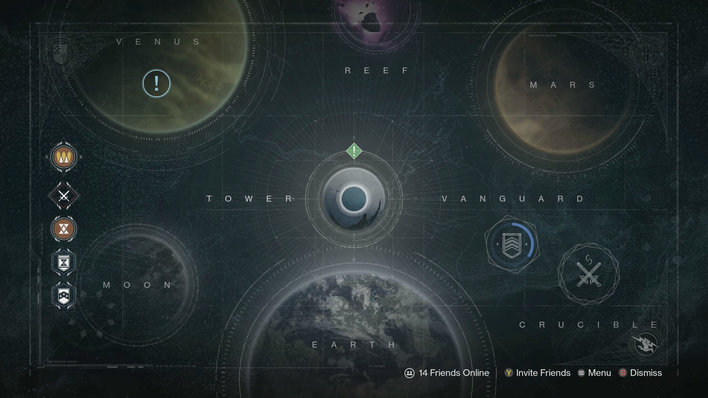
Pick a planet...any planet.
Destiny's narrative set up is as follows. In the present day, Mankind discover an otherworldly being on Mars, a giant white orb known as 'The Traveller'. The discovery of The Traveller sparks off a golden age of technological innovation and scientific prosperity for humanity, and after making its home in a low orbit in the Earth's atmosphere like a giant pale disco ball, The Traveller accelerates our growth across the solar system; terraforming other planets, tripling the average human lifespan, improving our tech and other such flashy miracles that giant space ball deities tend to do. However, it's not long before an evil force, imaginatively named 'The Darkness' (no, don't worry, it's not Justin Hawkins' band), shows up on the scene, with the intention of wiping out both The Traveller and humanity itself. Not good. Ever the loving, brave type, the Traveller sacrifices itself, and manages to save the last human city beneath it, where the remains of our civilisation have survived.
Some time after this catastrophic collapse, the game kicks off for you, the player, when a ghost - a robotic AI (Artificial Intelligence) machine created by The Traveller - revives your long dead body (this is never really explained anywhere, so just go with it for now), and sets you out on your adventure as a Guardian. The Guardians are special warriors that can wield The Traveller's light - in other words, kick some major ass and, you know, save the galaxy along the way and whatnot. You shoot your way through the tutorial mission, and upon finding your first rickety wreck of a spaceship, you head out on your epic quest to save the last remnants of humanity and The Traveller from the evil forces of darkness that are drawing ever closer...
Is it a bird? Is it a plane?
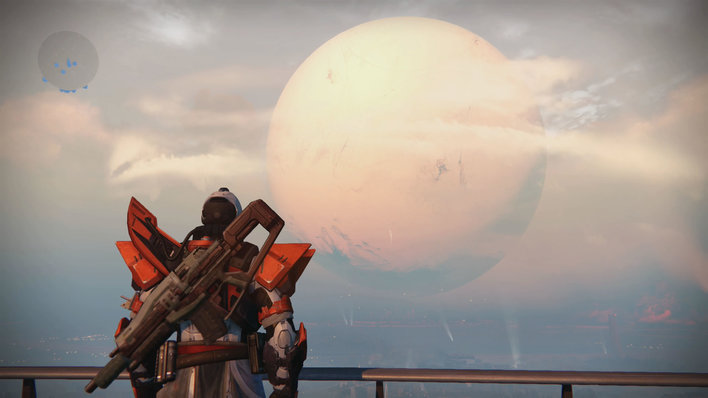
The Traveller, hovering in all its vaguely hinted at glory.
So what exactly is Destiny then I hear you ask? Is it a first person shooter? Is it an MMO? Hell, could it be an MMORPG? Is it none of these things and instead just a figment of our collective imaginations?
Let's start by going over some of the basics. Bungie describe Destiny as a 'shared world shooter'. It's a first person shooter - like Halo or Call of Duty series, but it's been built around social interactions with other players in the game world, much like a Massively Multiplayer Online game or MMORPG.
Much like in MMOs, you can complete quests, go on raids and take part in many other activities, all while happily levelling up your character to make them more powerful. And also like in MMOs, while many players do like to play solo, in Destiny, co-operation with other players is highly encouraged, and in most cases, essential to progress. .
Bungie certainly drew direct inspirations and influences from the structure of MMOs when developing Destiny, and, on the whole, it works quite well. In fact, it's arguably more of an MMO than a FPS in some key ways. Before we go into what works well and what doesn't, let's talk about the Guardian classes.
Classically trained
Each player in Destiny gets to create their own unique guardian; the idea being that every new player brings their own superhero-like space demon slayer to the fray to save the galaxy as a collective. Your Guardian's character choices are purely aesthetic ones - do you want to be male/female, have short hair/long hair, do you want to be a human, robot, or space elf etc. There's more to come about these races, and their lack of any real background shortly - but your choice of class is important, as it influences what style of combat you're going to be best suited to when the shooting starts. You've got three different classes to choose from when starting the game - Titan, Warlock or Hunter.
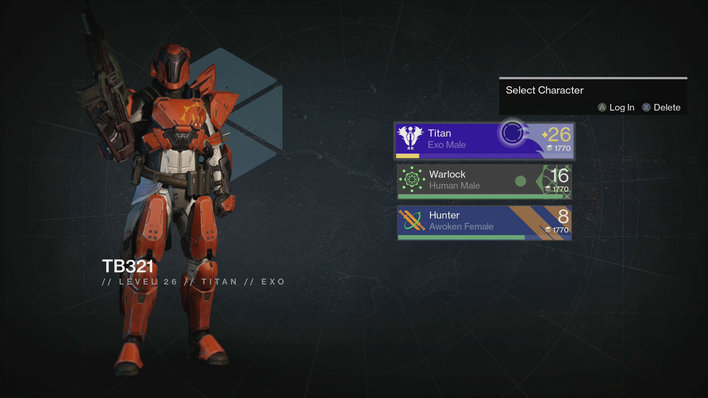
Titan.
The trio of classes operate like the typical classes you'd find in an MMO. The Titan is your Tank unit, a well-armoured tough-as-nails brute, who can take a lot of damage and dish it out as well. They're generally most useful at dealing with large groups of standard enemies using powerful area of effect attacks.
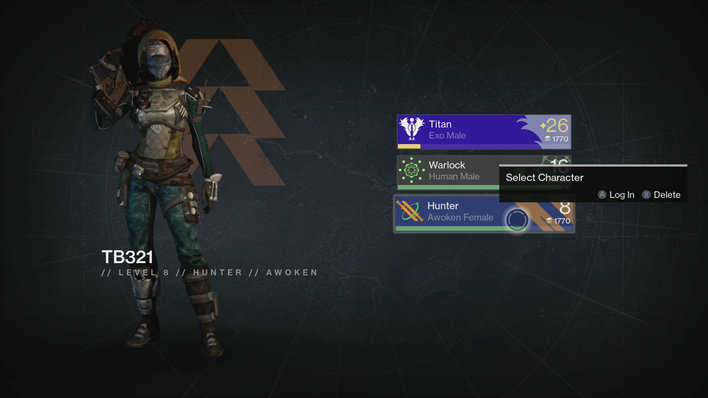
Hunter
The Hunter is your long ranged high DPS (Damage Per Second) character, who typically attacks from range, favouring sniper rifles and scout rifles; they also have some nifty throwing knives and special grenades to fling about, as well as a powerful golden gun attack which lets them inflict massive damage to enemies for a short period of time. Naturally, this makes them crucial to taking down tougher enemies and boss characters quickly.
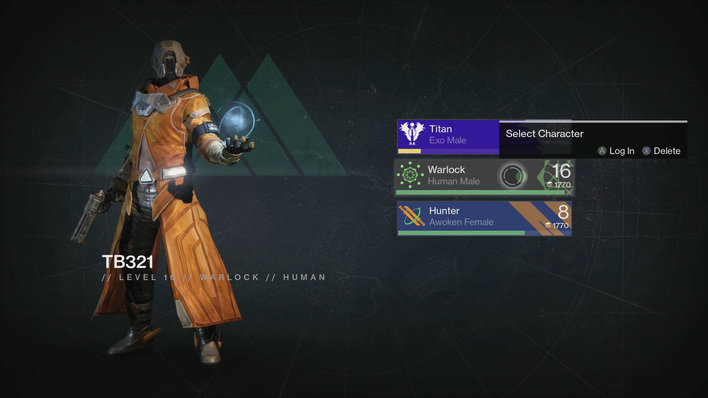
Warlock
Last, but certainly not least, the Warlock is a sort of mix between a support character and what's known in these circles as a 'glass cannon' - ie. a character capable of dealing tonnes of damage, but at the cost of being rather fragile itself. They fill in the middle ground between Hunter and Titan, capable of dishing out plenty of pain one moment and providing support and resources for the other Guardians the next.
Despite each class being naturally geared to a specific type of combat, each class can be tweaked to your own personal preferences. Each Guardian class has two 'Supers' (think special moves) which they can equip, each with their own separate skill trees to level up. Only one 'Super' can be equipped at once, and they operate in an offensive/defensive pairing.
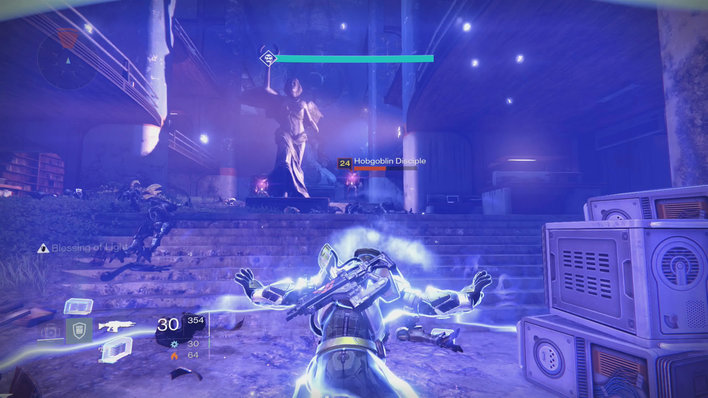
The Titan's defensive Super in action - Ward of Dawn.
Through careful tweaking of each Super's individual skill tree, all of the three classes can be largely customised to operate effectively in most combat roles, alone or as part of a fireteam (for the most part, fireteams are three-person max groups of players that you can adventure through the missions together as).
For example, you could design your normally slow and heavy Titan to be super quick and speedy at the cost of its armour, and likewise, you could tweak your normally fragile Warlock to be super tough and more bullet resistant at the cost of its speed and damage output. It's all down to what works best for you. All guns can be used by all classes; however, some classes are naturally suited to wield certain weapon types over others, and will usually receive appropriate bonuses - for example, a Hunter's armour will likely give boosts that support the use of sniper rifles, whilst a Titan's armour will usually grant advantages with machine guns.
While it's good that the classes are designed to be flexible in this way, unfortunately, this also means that when fully levelled up, each class can start to feel indifferent to each other. Combined with the fact that every class can wield every gun, it soon becomes apparent that it's not particularly important to have a balanced team of different skills and talents to overcome the alien hordes with; no, just make sure everyone in the fireteam brings their biggest and best guns and you'll be just fine.
This isn't a major problem as such, but it does undermine the idea of putting together a holy trinity of the three classes as a single cohesive combat unit - you're just as likely to get through the same story mission with three armed to the teeth Warlocks as you are having a fireteam made up of all different classes. Oh, and speaking of the story missions...
Halo darkness, my old friend...

A Hive Acolyte - far too close for comfort.
Remember earlier when I was telling you about Destiny's plot? The Traveller, The Darkness, evil space aliens, doom and gloom and all of that jazz - so far, so good right? Well, all of this is explained in the game's opening cutscene. Make sure you're paying attention to this cutscene, however, as that's pretty much the extent of the story you're going to get for the entire game! Yes, really!
This is the biggest disappointment with Destiny. If you're a long-time Halo fan, it's a massive disappointment just how comparatively poorly the narrative barebones of this potentially very interesting plot set-up are actually fleshed out. In fact, upon getting about halfway through the game, you soon realise that despite seeing a few scant cutscenes here and there that might have at one point suggested otherwise, the horrifying realisation that no, there actually isn't anything resembling a story to sink your teeth into.
From the very start of the game, to the surprisingly quick end (the story mode can be played through in about 6-8 hours), you'll find yourself asking largely the same questions you had at the very beginning - what exactly is The Traveller? Why are there suddenly robots (the Exo) and shiny blue space elves (the Awoken) being nonchalantly classed as part of humanity as if we've always had them? Why have I not met any other significant characters yet? Bungie may be planning to run and support this as a franchise for a decade, but come on - it desperately needs some characters and plot to go on now, let alone in ten years' time.
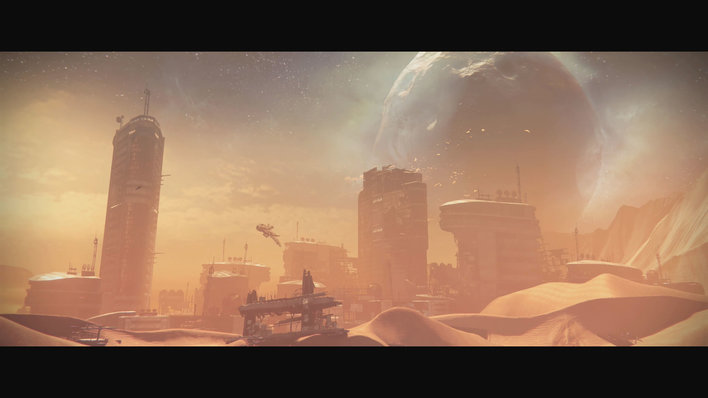
The ruined cities of Mars. Unfortunately, we're still none the wiser as to how they got ruined in the first place.
To be fair here, as popular as the stories and plots of the wider Halo universe are, they aren't exactly the most original and ground-breaking things ever. Yes, you've got the usual space marine clichés, and at times the cheesy military gung-ho attitude bursting forth at the game's power armour clad seams might be a bit ridiculous, but the stories were delivered in a well polished manner and, like the Master Chief himself, stuck to their (many) guns, delivering a dramatic space opera in the process.
However, even for those who haven't played the Halo series, the weak threads of Destiny's story will still be a bit of a major let-down to say the very least, no matter what your stance on narrative in games is.
Letter of the lore
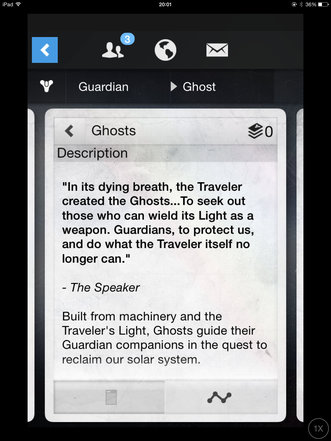
The Grimoire Ghost Card. This is from the Destiny Companion App - you can't access these from the game whatsoever right now.
As you play through Destiny, notices will pop up after killing enemies, collecting loot, completing story missions and finding items, saying that you're unlocking new Grimoire cards. "But lo - what are these Grimoire cards of which you speak Reviewer?", I hear you cry. Well, these cards are essentially lore cards that give extra information on the enemies, locations and weapons that you'll come across as you play through the game.
It's interesting enough to flick through - and, going by other players' more extensive reading, there's now some cool theories circulating online about just what exactly is going on in this sci-fi universe, and whether everything is as it narratively seems to be - but it's all entirely separate from the actual game. There's actually no way to access any of this content from within the game itself; you instead have to log into a Bungie.net account or fire up the Bungie Companion App to read your collection of lore cards, which seems like a massive oversight. Even just having the utility to access your Grimoire cards in some out of the way options menu would have been adequate, but to make the player have to go and read up on the lore via a separate app, or through the Bungie.net website to get the story that didn't make it into the final game seems like a really counter-intuitive decision.
It's a real shame, because at times, with the beautiful art direction, evocative soundtrack and the social interactions between players, Destiny gets very close to capturing that sense of awe and wonder that Bungie really nailed when you first set your amour-clad foot upon the eponymous ringworld of the Xbox classic, Halo: Combat Evolved. There's certainly plenty of mysteries out there in Destiny's universe, but you won't be getting engrossed and drawn into them by playing the game at the moment, that's for sure. Luckily, you won't need to be.
Why Halo there

A Vex Minotaur, coming in close for some gentlemanly fisticuffs.
While Destiny has little to no story or characters, its real strength is in the gameplay. Anybody who's played the Halo games will instantly feel right at home here; from the power and handling of the guns themselves with their thunderous reverberating gunshots, to the nuanced design, look and behaviours of the enemy alien species you'll be riddling holes in with said powerful guns, the gun-toting gameplay in Destiny feels unmistakably Bungie, and thus, unmistakably fantastic.
The guns are all similar staples of ones found in the Halo universe; you've got such classics as all-out assault rifles, versatile three-burst pulse rifles, precise single shot DMR-like scout rifles, alongside fan favourite power weapons such as sniper rifles, shotguns and rocket launchers. Each gun has its own particular chunky feel, sound and weight, and you'll amass a whole plethora of different armaments to mix and match as you see fit on your inter-planetary jaunts.
The loot system is the other big draw, and it's how you'll be acquiring the vast majority of your weapons and gear in the game. For the most part, the loot drops work well. All the loot in your game is unique to you, as each player gets their own independent loot stream - which is great design, as it means no more squabbling over who gets that shiny new gun or helmet a boss dropped, as was prone to happen on a frequent basis in games like Diablo III or Borderlands 2.
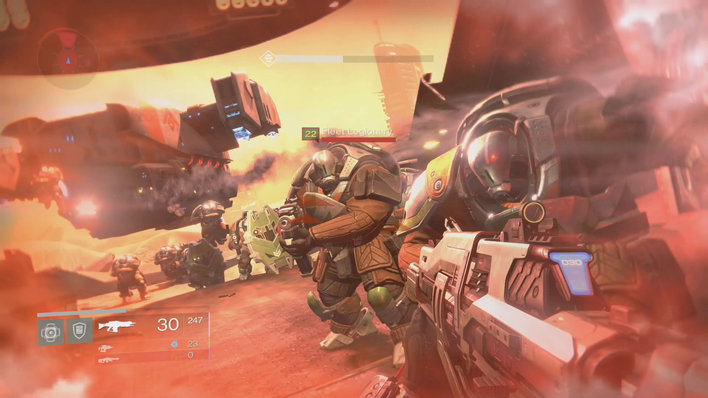
A full frontal Cabal assault. In a word; painful.
Destiny's enemies comprise four different alien races, each with their own unique abilities and tactics. Although all four have their own interesting combat strategies, weaknesses, enemy types and class hierarchies, it's the last two you'll encounter - the robotic Vex and the lumbering highly-armoured Cabal - that prove the most challenging and interesting to fight. The Cabal in particular are great for co-op play, as many of their troops carry impenetrable shields, requiring you to co-ordinate with your teammates and flank them in order to take them down successfully.
As the game is designed like an MMO however, with separate 'instances' (an MMO term for a specific portion of the world map that a particular bunch of players are currently in) when players move off, the enemies will routinely spawn back in and head back to predetermined spots, which undermines their otherwise good intelligence, and at times, can remind you that you're not exactly playing a first person shooter or an MMO - it's a blend of the two, a hybrid, which comes with definite pros and cons. In fact, as a result of this, at times, very predictable enemy behaviour, there's now a growing number of players that have found so-called 'loot caves' to farm; places where enemies will constantly respawn over and over again after being killed, allowing players to repeatedly grind away, killing them repeatedly in the hope of acquiring loot at a faster pace than otherwise possible. It's not a massive thing, but it does undermine the feeling somewhat that you're playing against smart and responsive enemies from time to time.
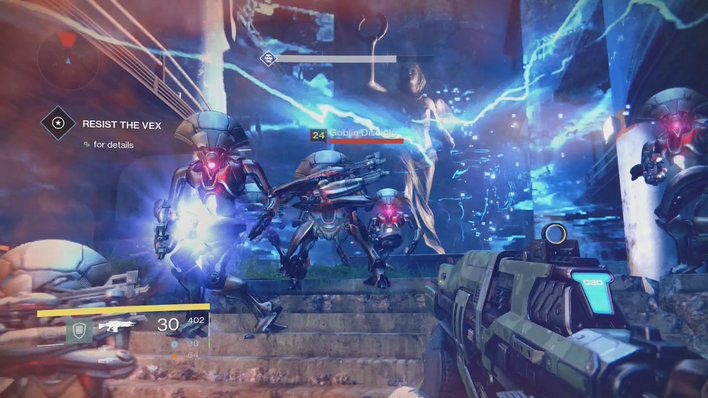
A horde of pesky Vex Goblins. Vexing indeed.
Last but not least, with all this talk of good Halo-esque comparisons, the soundtrack deserves particular credit for building and sustaining Destiny's atmosphere. Martin O'Donnell's superb scores work wonderfully well to establish the world and environments with atmosphere and character...which is just as well, as there are practically no other characters in the story aside from you and your Ghost, AKA the Dinkbot.
Game of Drones
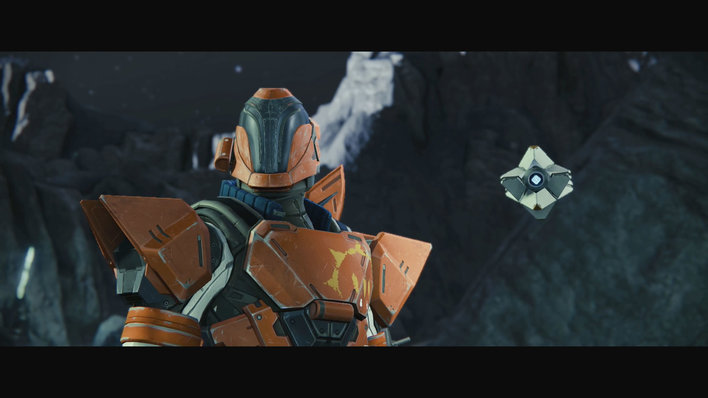
Guardian and Dinklebot; the ultimate duo in intergalactic crime fighting.
The Ghost is voiced by Game of Thrones actor Peter Dinklage, and he's your main companion on your adventures throughout the solar system. In fact, with a couple of exceptions towards the end of the game, he's practically the only other character you have any meaningful narrative interaction with.
It may have been parodied to death already on the internet, but if we're talking about the Ghost, it needs to be said - Peter Dinklage's wooden delivery of his lines leaves you really wanting more. From my experience, yes, whilst it's true that the Dinkbot isn't the most charismatic companion that will ever accompany you across a virtual landscape, it's the poor quality of the material that he's got to work with that lets his performance down the most.
To bang on about it once again, with no other characters to interact with, and with a great deal of the narrative stripped out of the game and put into the Grimoire cards as external lore, the weak writing is laid painfully bare, time and time again.
Also, despite Destiny's strong focus on continually connected online multiplayer, co-operative play and the shared stories that emerge from playing and interacting together, it's strange that, on the rare occasions when you do get a story cutscene to watch, only your character is displayed, and none of your fellow fireteam members appear with you. It's not a big thing, but nonetheless it is a bit jarring if you aren't playing solo. Considering that arguably the absolute core tenet of the game is to join up with your fellow gamers and tackle the story's villainous mobs of aliens together, it feels like a bit of a confusing misstep to isolate you from your friends during the cinematic moments.

"Fly me to the moon, let me...hover among the stars..."
Apart from these very occasionally occurring cutscenes, most of the game is spent wandering around the various planetary vistas with your own personal robo-Dink in tow. Unfortunately, despite how beautiful these areas are, they feel lifeless and hollow; there's nothing really going on in them apart from them being home to endlessly respawning monster closets - spewing out hordes of enemies every few minutes, which eagerly rush back into their set positions to once again be slain over and over again, ad infinitum.
So, the weak story, combined with a very repetitive mission structure, begins to quickly feel stale and tired after only a few missions in. At times, Destiny's missions can be so formulaic in structure it's laughable. A typical story mission usually goes as follows:
Start of mission. Cue a substantial exposition dump of woolly information/backstory from Dinkbot to set you on your way. Go to objective location. Kill enemies. Go to next area, cue more story waffle. Kill enemies in this location, go to new location. Kill last bunch of enemies, maybe slaying a few tougher enemies along the way and possibly even a boss character to finish. End of mission. Cue breakdancing and teabagging a plenty. Return to planetary orbit. Go to Tower. Cash in engrams with Cryptarch, cash in completed bounties, and buy new gear and supplies if neccessary. Head back into orbit, pick new destination and mission. Rinse and repeat.
On reflection though, perhaps it'd have been naïve to go in expecting a story comparable to that of Halo's. After all, the game isn't a straightforward single player game. To bring up Diablo III as a point of reference again, there's a hugely successful game because of its gameplay, not its storyline - and if you go in expecting a similar experience, you'll probably like Destiny. It's not about what or why you're doing the things you're up to in Destiny, it's about
who you're doing them with. Once you come to this epiphany of a realisation, the game really steps up a gear and comes to life.
A little help from my friends

Guardians at the Tower.
Having played the game both solo and with friends, it's safe to say that Destiny is far more fun together. The ability to bump into friends and other adventuring players on your travels really transforms what otherwise might have been a bland regular shooter into something truly unique and fresh. That said, the lack of local co-op is hugely disappointing, especially considering Bungie's history with Halo - a game that's always supported split screen, on apparently infinitely less powerful consoles. When it comes to Destiny, just having friends who play games isn't enough - you need to have friends who play games, have the same console as you, and each have their own copy of Destiny.
The Tower is possibly one of the greatest things about the game. It's essentially the main game hub; you'll use the Tower as a place where you can meet up with your friends, buy new gear, and decrypt engrams you find (think bright colourful footballs containing mystery gear) from the Cryptarch. You're normally coming to and from the Tower with a specific purpose in mind, but some of the best moments are when you're just waiting around and mingling with the other players.
Mingling is easy; the D-pad lets you perform simple gestures, allowing you to communicate non-verbally with your fellow Guardians, including waves, points, sitting down (to show when you are AFC, or 'Away From Console') and, of course, dance routines; naturally, this leads to some daft player interactions. Seeing a mass breakdance party kick off in front of one of the Tower vendors is always funny.
As much as these gestures are great ways of interacting with your fellow Guardians, it's the spontaneous way that you will naturally stumble across other players going about their own business while out on your own individual missions that make the biggest impression.
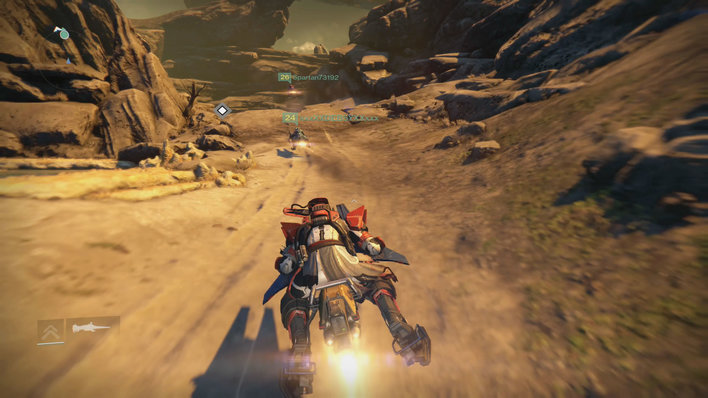
The Sparrow, your Guardian's very own Star Wars-esque speeder bike, makes getting across levels a real thrill.
The emergent stories that arise from players coming across each other out in the wilds of the shared worlds are some of my own personal highlights from the game, and it's this sort of storytelling that Bungie is counting on players experiencing when they go off adventuring as a fireteam.
When these special moments of spontaneous player interaction happen, they feel nothing short of magical. At their very best, you can experience something totally spur of the moment that feels like it's been carefully scripted, and you'll be talking about it for days.
On one occasion, after wandering off the beaten path on a basic story mission on the Moon, I found myself lost deep within the Hive-infested tunnels below the surface. Think wandering around in the mines of Moria from The Lord of The Rings, only with space zombies, space knights and a cave troll-like Ogre that can rapid-fire lasers from its face, and you're in the right ball park.
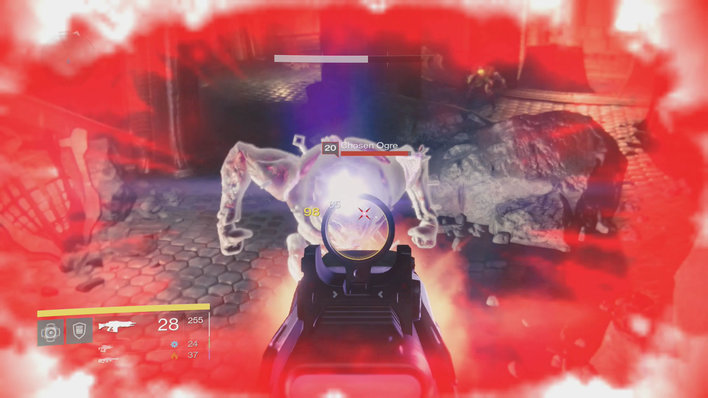
Fee-fi-fo-RUN!
I fought for my virtual life throughout these gloomy dank catacombs for absolutely ages, hoping to find some secrets or perhaps just another way out, only to be greeted at every turn by hordes and hordes of enemies keen to make my acquaintance. Wonderfully oppressive (as strange as that sounds), it created a heavy atmosphere of desperation, horror and dread that managed to draw me into the game world in a visceral way that the story completely failed to do. Being lost in a game normally swarming with other players makes you feel anxious yet electrifyingly engaged.
It took a long time, and an awful lot of bullets, but I eventually found a way out. Upon finally stumbling back outside onto the dusty lunar plains, my relief at seeing other players milling about and merrily dancing around each other was a moment of release. After being truly alone for a good hour or so, it's hard to express how it felt to be around other players again - it's easy to take the shared experience feel of the game world for granted.
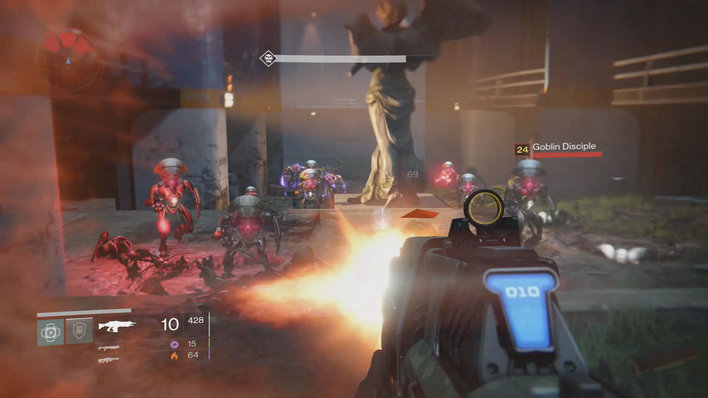
"I'm, too Vex-y for my shirt...erm, power armour."
Another time, I was making my way through the Aztec-like ruins on the planet Venus (as you do) when I stumbled across a large group of players fighting off swarms of teleporting Vex machines. At first I had no idea what they were doing, but they were getting bombarded on all sides, so feeling the pull of bystander intervention, I shouldered my auto rifle and joined the fray. As it turned out, this was a raiding group I had stumbled across, and they were currently in the process of raising a spire to gain access to the Vault of Glass - Destiny's first raid mission. Although I was a tad under-levelled in comparison to the rest of the group, I lent my firepower to their cause, helping them to hold the incoming Vex troopers off whilst defending the spire platforms in order to get the massive vault door open. It was an absolutely exhilarating battle to have just spontaneously walked into off the cuff. Sadly, although I couldn't progress further into the Vault of Glass with them, it felt incredibly satisfying to have played a bit part in helping them on their way.
The Crucible

Guardians strutting their stuff in the Crucible. I'm the one holding the flag - the team mascot in other words.
Once you feel like you've slain your fair share of gruesome space ogres and time-travelling robotic war machines for the day, it's time to kick back and head into the Crucible for a while. This is Destiny's competitive PvP (player vs player) mode, where Guardians can battle each other for experience points, Crucible marks (one of the game's special currencies) and, of course, fancy loot.
While perhaps not the most unique competitive multiplayer experience out there, the Crucible is fast-paced, exhilarating and a lot of fun. Most importantly though, it's simplicity makes it a very accessible place to start for those who might otherwise not have bothered with a competitive shooter experience before.
The interplay between the Crucible and the regular co-op missions works brilliantly. Bungie have wisely allowed players to decide how and what they want to play in Destiny, gently encouraging them to try new experiences without forcing players into a painful grind in modes that they won't enjoy.
Everything applies back to your character, so any cool gear or guns you earn in one mode can be used to help you out in another. All the gear and guns you earn in the game work in both PvP and PvE (player vs (AI) enemy) modes, so all the progress and rewards you earn in the Crucible you can carry over and use in the co-operative story mode also. As we aren't the biggest fans of competitive shooters, we've naturally spent the majority of our time in Destiny in the co-operative modes. Being able to bring across our favourite guns and gear from the story to the Crucible and vice versa definitely makes a big difference, and gives an added incentive to jump into the Crucible from time to time.
Although players are complaining that the competitive multiplayer doesn't completely balance out weapon stats - the game apparently only balances out the basic stats, and not some of the additional special effects the legendary and exotic weapons come with - I've personally not come across this problem myself. From my own experience of the Crucible, regularly playing at different experience levels with different combinations of weapons and gear, it seems that much like other competitive games with ranking systems, a player's number or rank is just an indicator of how long they've been playing the game, and this doesn't necessarily correlate to their true skill. Unless you're playing an Iron Banner event (a special limited availability competitive mode that was playable in the Beta, where gear and gun advantages aren't levelled out), then generally you don't have to worry about other players having unfair advantages over you; the Crucible still manages to be a fair test of player skill for the most part, and an enjoyable PvP alternative to the story/co-op missions.
However, high level competitive first person shooter players have voiced their complaints at the lack of private lobbies, and the lack of other features that they've come to expect from similar competitive online first person shooter games. Unless these are patched in quickly, the game will likely not catch on significantly in the pro/e-sports communities.
Light at the end of the (ambiguously long) tunnel

Loot, glorious loot.
With all these story missions and Crucible matches under your belt, you'll soon find your Guardian levelling up at a reasonably fast rate. The upgrades come thick and fast, and you'll have amassed a decent pile of guns and gear in your inventory. In fact, levelling up happens so fast, you'll find yourself at the level max rather more quickly than you may have anticipated.
Destiny has a relatively low experience level 'soft-cap' which can be reached with only a few hours on the clock. Although this itself isn't necessarily a bad thing - the level cap of 20 has been repeatedly stated by the developers to be only the start of things with regard to the end-game activities - this is by all means a relatively low level cap in comparison to other big loot and grinding games such as, you guessed it, Borderlands 2 and Diablo III. Reaching the cap in those games can take hundreds of hours of play, whereas you'll reach level 20 in Destiny in a mere fraction of that time.
Obviously, just having to grind for grinding's sake does not a good game make, but your climb up the experience ladder in Destiny will most likely feel a bit anticlimactic to say the least. Combined with a relatively small number of unique missions and things to do, this does leave a bit of a bitter question mark hanging over the player's head, with an unpleasant lingering notion of "Is that really it?" Well...not quite.

Finding gear with more light requires both patience and luck...lots of luck.
I say there's a soft-cap of 20, because in actual fact, you can go past it. To level up past 20, you need to start acquiring wearable armour and gear for your character that have 'light' in them. This appears as a new statistic on the wearable gear you'll find going forward, which you'll need to move up into the post-20 levels (level 30 being the final cap for the time being). It's at this point that the loot system goes from working nicely to being a cheap lucky-dip apple bobbing contest in a hand cannon's muzzle flash.
The loot, armour and guns you'll find while playing and that you'll receive as mission rewards are, as far as I can tell, entirely luck based. You'll still earn experience points as you did before, but once you're at level 20, they only count towards levelling up your currently equipped gear, special ability and guns. From here on out, it's totally down to lady luck as to if and when you get gear with better light ratings. Get a high enough light rating from your gear and you'll go up a level. Don't find anything with higher light ratings and, well...you could be stuck there for some time, and there's nothing you can do about it except to get that plucky nose of yours back to the grindstone. All of a sudden, this turns levelling up from a smooth gradual incline of progress into a jagged stop-start purgatory-like traffic jam.
Essentially, once you're at the soft-cap the loot system degenerates into a game of chance. At level 20 and beyond, whether you're playing in The Crucible or carrying out story/co-op missions, you're playing with your fingers crossed at all times, hoping that any loot you come across has more light. There's no other way to progress.
With all this chance involved in getting past the soft-cap, you might well ask "What's the point in doing all this extra levelling up past 20? If it's all down to luck, why spend hours grinding trying to go any further?" Well, it becomes particularly important if you want to experience the end-game content such as the raids. These are the key features of the game that Bungie are keen to impress upon players as the best bits of the entire Destiny experience.
Raiding between the lines

The fearsome Fallen Devil Walker can be a particularly tough nut to crack.
Raids are particularly difficult missions that require a team of six players to come together and tackle gruelling enemies and massive bosses, much like MMO raid players do in games like World of Warcraft, in order to get their hands on some of the most rare and powerful loot and weapons in the game for their characters. Raid missions require fireteams to have unrivalled communication skills, co-operation and teamwork in order to pull off these most difficult of missions successfully.
Here's why levelling up is important past the soft-cap. It's suggested that players need to be at least level 26 minimum to be in a decent position to start tackling the raids, and about level 28 in order to competently take part. The bottom line; these raids are pretty damn hard. To even begin thinking about tackling a raid before getting to the higher post-20 level is pretty much suicide, hence why you'll need to spend a good portion of time beforehand grinding away for better gear, and hoping you'll chance across enough decent gear with light in it.
Destiny's apparently hard-as-nails endgame content sounds terribly exciting. I say 'apparently', and 'sounds terribly exciting', because as of yet, I haven't been able to play them. I'm essentially twiddling my virtual thumbs as I wait for my friends to level up. I'm a level 26 Titan myself (lucky me), but I've got to wait for my five other friends to have the same luck with light-filled loot that I've had, because here's a bombshell - there's no matchmaking system in place for the raids, and the weekly heroic/nightfall challenges (these are also pretty tough).
This means that unless you have five other highly-levelled and tooled-up friends playing Destiny, you won't be able to get access to arguably some of the best gameplay and experiences that the game has to offer.
Why offer extensive and technically impressive matchmaking systems throughout the majority of Destiny, only to snatch them away for what are supposed to be the best bits of your game? In fact, as far as I'm aware, the game doesn't actually tell you anywhere how to start up your own in-game clan (Destiny's integrated online team system, designed to help you organise raid dates and times etc. with all of your clan members as a whole). I'm only aware of the clan system and how it works from my previous experience with Bungie's Halo clan systems over the years. I can only imagine that there's going to be lots of people out there who won't ever get to experience what's touted as Destiny's best bits, as it's not sufficiently explained to them in-game.

Sepiks Prime - AKA that giant electric floating eyeball thing, is also quite a brute on the harder difficulties.
From past experience, Bungie's Halo games that they can be particularly heavy-handed when it comes to how they want you to play their games online. It's even understandable why they want you to just solely play the raids with people you have in your clan/friends list to some extent - you're more likely to talk and communicate with people you know, players are less likely to unexpectedly drop out, and overall you'll generally be more comfortable and more likely to get into the heat of the action as you navigate through these difficult dungeons together, where real-time tactics and communication are no doubt keys to success.
Friends-only raiding is absolutely a nice idea in some ways, but it feels impractical, and very prescriptive considering how open and flexible the rest of the game is. Bungie's stance on the raids, unfortunately, seems to be unnecessarily difficult and officious. They seem to have this overblown romantic idea of how you're supposed to be playing alongside your online friends. You and these fine, brave men and women you've banded together with on your epic journey; these noble warriors of old, armour clad and powerful, standing tall with the galaxy's finest weaponry in their hands. Actually, no, not quite - I just want to play a raid for a few hours if that's quite all right Bungie?
Does it really matter if we fail hopelessly at a raid? Can I not be allowed to try and fail on my own terms? I couldn't care less if I repeatedly failed, or the team doesn't communicate properly, or we just simply can't pull it off in the end because people want to breakdance all the time - isn't it the taking part that counts after all? Anyway, enough of these rhetoricals - to the Batcave! No wait, that's not right - to the conclusion!
To infinity, and beyond

Set the controls for the heart of the sun...actually, on second thought, let's go back to Earth instead.
So that's Destiny, in an admittedly rather large planetary-sized nutshell. The game is fantastic and ground breaking in a lot of ways, but it has so many critical problems at its foundation. Some of these are just so inconceivably basic, especially so when you consider the amount of money that was reportedly pumped into the game - a whopping $500 million was the original (later said to be inaccurate) figure.
As a result, you'll find yourself asking, "How did they manage to get this so wrong?" at times, only to be blown away mere seconds later by some ridiculously exciting spontaneous event that kicks off and gets everybody in the area playing together and having a genuinely good time. There's moments where you'll be truly amazed by what's going on in Destiny, marvelling at how fresh and exciting this socially connected playing space is, only to find out how fragile and stale it is in places, like an abandoned flimsy cardboard film set, with no actors in sight for miles.
Despite the flaws, I've thoroughly enjoyed my time in Destiny, and I plan on spending many more hours looting and shooting my way back and forth across the solar system for a long time yet. In terms of new content coming to the game over in the near future, there's two paid expansion packs that have been announced as part of the Destiny Season Pass - The Dark Below and House of Wolves, with another two unannounced packs to follow, and free updates and patches for the game are rolling out on a pretty regular basis, so you clearly feel that the game has a great deal of support right from the off.
For me though, when I think about Destiny, it's all about the guns and gameplay. The shooting mechanics in Destiny are an example of Bungie at it's finest - from the moment you pick up that first ancient and rusted assault rifle in Old Russia, you know you're in for something special. So special, in fact, that longtime Bungie fans will swear that they're holding their gun in some very familiar green MJOLNIR power armoured hands.
Format Reviewed: Playstation 4




















